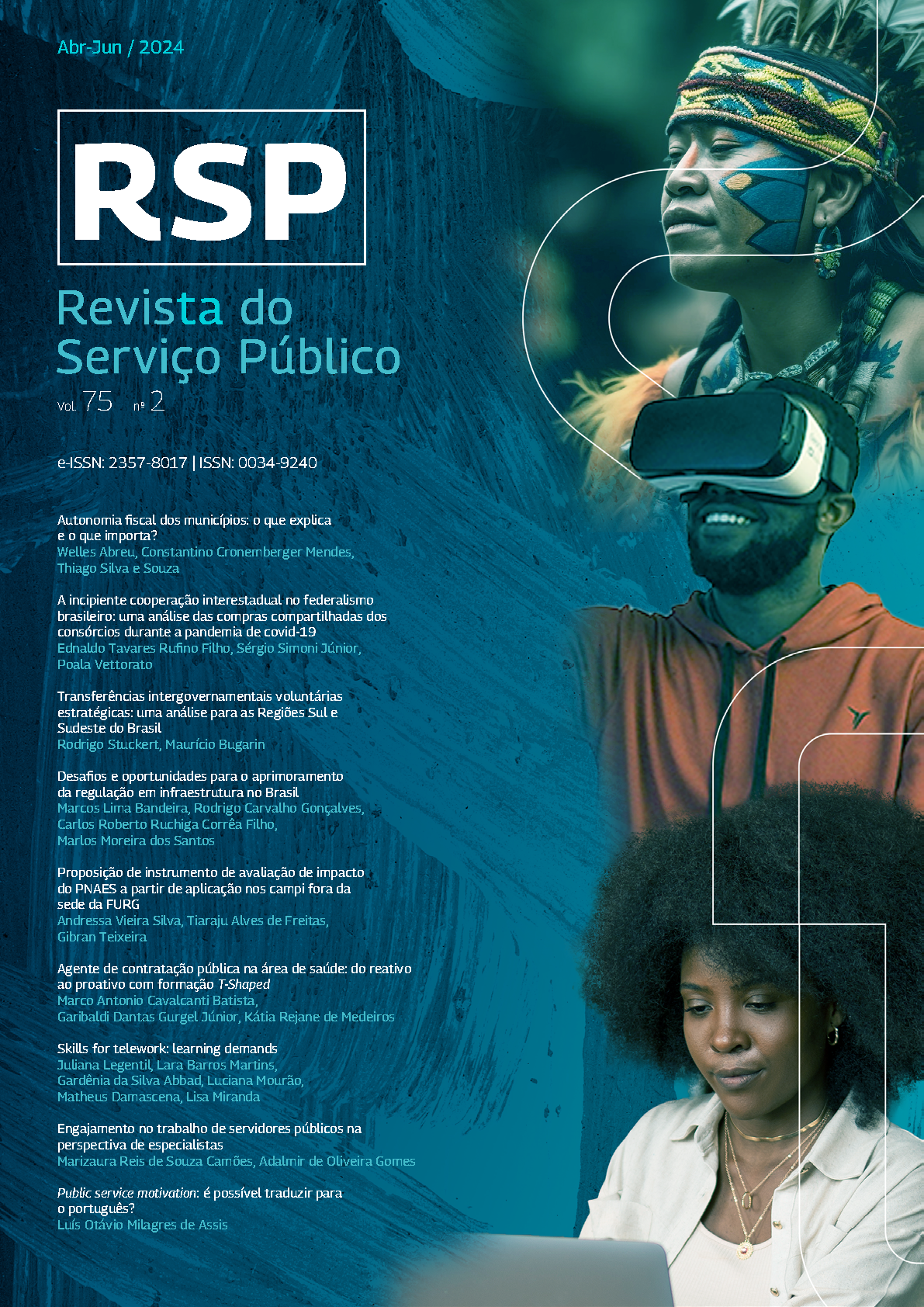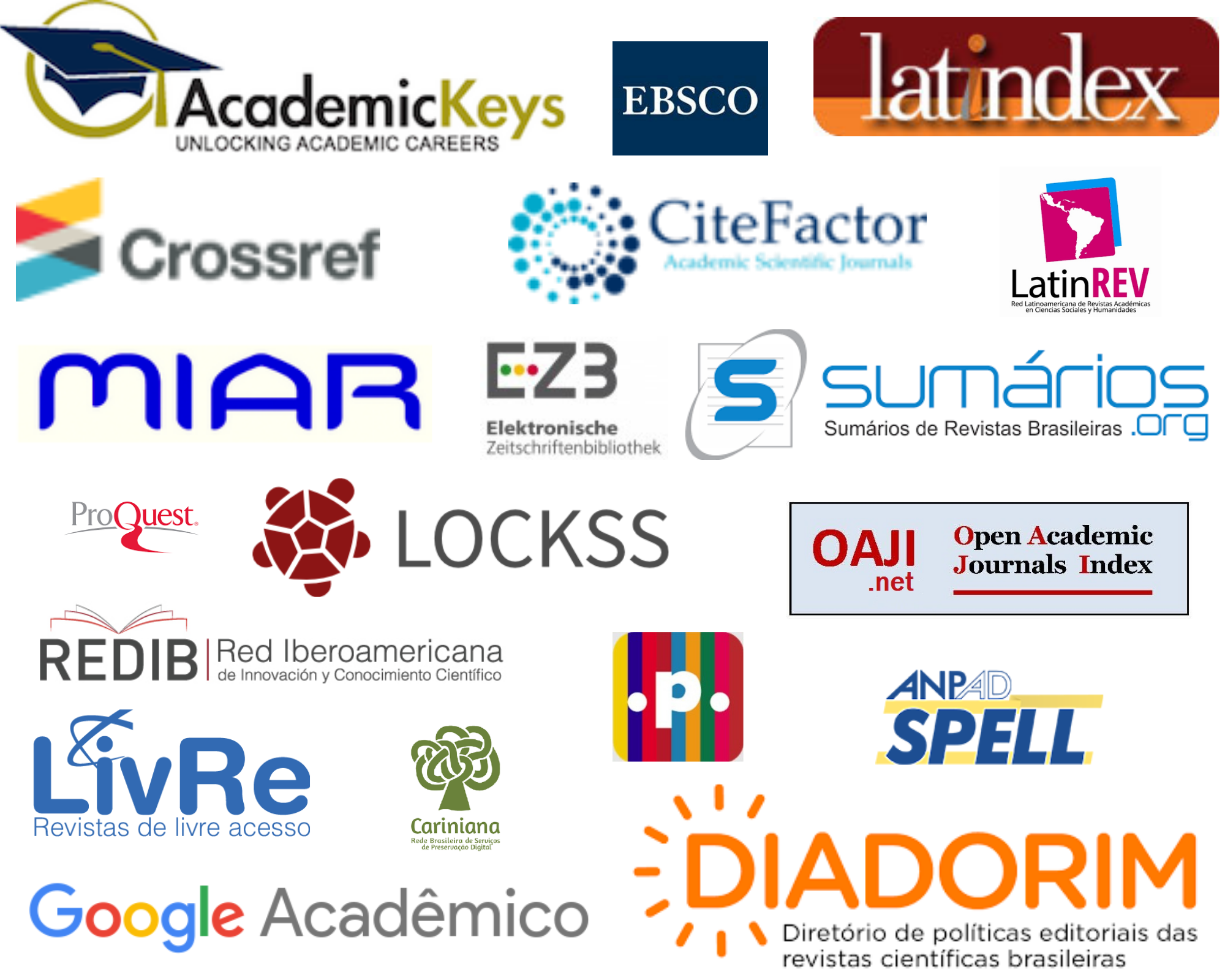Public service motivation
is it possible to translate into Portuguese?
DOI:
https://doi.org/10.21874/rsp.v75i2.10196Keywords:
motivation, international comparison, surveyAbstract
Only in 1990 science began producing systematic studies seeking to investigate whether there are specificities in the dynamics of work motivation among employees in public organizations compared to private institutions. To understand these specificities, James Perry coined the concept of public service motivation (PSM). This article first reviews literature on PSM synthesizing the findings of more than 30 years of empirical research. The analysis shows that the international validity of this concept is controversial and that the findings are not automatically applicable to Brazil. For this reason, a second objective is the validation of a short metric to measure PSM on Brazil. Finally, from a survey with 443 public servants, preferences for intrinsic and extrinsic rewards are analyzed and compared to international research. The result shows a motivational dynamic similar to that of developed countries, at least in part of public administration.
Downloads
References
Andersen, L. B., Heinesen, E., & Pedersen, L. H. (2014). How does public service motivation among teachers affect student performance in schools?. Journal of Public Administration Research and Theory, 24(3), 651-671.
Banco Mundial (2017). Um Ajuste Justo: análise da eficiência e equidade do gasto público no Brasil. Disponível em: https://www.worldbank.org/pt/country/brazil/publication/brazil-expenditure-review-report. Acesso em 20/12/2018.
Bearden, W. O., & Netemeyer, R. G. (1999). Handbook of marketing scales: Multi-item measures for marketing and consumer behavior research. Sage.
Bolino, M. C., & Grant, A. M. (2016). The bright side of being prosocial at work, and the dark side, too: A review and agenda for research on other-oriented motives, behavior, and impact in organizations. Academy of Management Annals, 10(1), 599-670.
Brewer, G. A., & Selden, S. C. (1998). Whistle blowers in the federal civil service: New evidence of the public service ethic. Journal of public administration research and theory, 8(3), 413-440.
Buelens, Marc e Broeck, H. V. (2007). An Analysis of Differences in Work Motivation between Public and Private Sector Organizations. Public Administration Review 67, 65-74.
Bullock, J. B., Stritch, J. M., & Rainey, H. G. (2015). International comparison of public and private employees’ work motives, attitudes, and perceived rewards. Public Administration Review, 75(3), 479-489
Cerasoli, C. P., Nicklin, J. M., & Ford, M. T. (2014). Intrinsic motivation and extrinsic incentives jointly predict performance: A 40-year meta-analysis. Psychological Bulletin, 140(4), 980.
Chen, C. A., & Hsieh, C. W. (2015). Does pursuing external incentives compromise public service motivation? Comparing the effects of job security and high pay. Public Management Review, 17(8), 1190-1213.
Choi, Y. (2017). Work values, job characteristics, and career choice decisions: Evidence from longitudinal data. The American Review of Public Administration, 47(7), 779-796.
Cowley, E., & Smith, S. (2014). Motivation and mission in the public sector: evidence from the World Values Survey. Theory and decision, 76(2), 241-263.
Crewson, P. E. (1997) Public-service motivation: building empirical evidence of incidence. Journal of Public Administration Research and Theory 7, 499-518.
Dur, R., & Zoutenbier, R. (2014). Working for a good cause. Public Administration Review, 74(2), 144-155.
Eisenhardt, K. M. (1989) Building theories from case study research. Academy of Management Review 14, 4, 532-550.
Giauque, D., Anderfuhren-Biget, S., & Varone, F. (2013). Stress perception in public organisations: Expanding the job demands–job resources model by including public service motivation. Review of Public Personnel Administration, 33(1), 58-83.
Hair, J. F., Black, W. C., Babin, B. J., Anderson, R. E., & Tatham, R. L. (2009). Análise multivariada de dados. Bookman Editora.
Hair Jr, J. F., Hult, G. T. M., Ringle, C., & Sarstedt, M. (2016). A primer on partial least squares structural equation modeling (PLS-SEM). Sage publications.
Hanna, R., & Wang, S. Y. (2017). Dishonesty and selection into public service: Evidence from India. American Economic Journal: Economic Policy, 9(3), 262-90.
Houston, D. J. (2000). Public-service motivation: A multivariate test. Journal of public administration research and theory, 10(4), 713-728.
Houston, D. J. (2011). Implications of occupational locus and focus for public service motivation: Attitudes toward work motives across nations. Public Administration Review, 71(5), 761-771.
Kim, S., Vandenabeele, W., Wright, B. E., Andersen, L. B., Cerase, F. P., Christensen, R. K., ... & Palidauskaite, J. (2012). Investigating the structure and meaning of public service motivation across populations: Developing an international instrument and addressing issues of measurement invariance. Journal of Public Administration Research and Theory, 23(1), 79-102.
Kjeldsen, A. M. (2014). Dynamics of public service motivation: Attraction‒selection and socialization in the production and regulation of social services. Public Administration Review, 74(1), 101-112.
Klein, F. A., & Mascarenhas, A. O. (2016). Motivação, satisfação profissional e evasão no serviço público: o caso da carreira de especialistas em Políticas Públicas e Gestão Governamental. Revista de Administração Pública, 50(1), 17-39.
Moraes, L. F. S. (2017). Uma análise da relação entre a motivação para o serviço público e a intenção de saída na perspectiva dos servidores brasileiros. Tese de doutorado. Centro Universitário FEI.
Naff, Katherine C., and John Crum. 1999. Working for America: Does Public Service Motivation Make a Difference? Review of Public Personnel Administration 19(4): 5–16.
Netemeyer, R. G., Bearden, W. O., & Sharma, S. (2003). Scaling procedures: Issues and applications. Sage Publications.
Pacheco, Regina S. (2010) Profissionalização, mérito e proteção da burocracia no Brasil in Burocracia e política no Brasil: Desafios para a ordem democrática no século XXI. Rio de Janeiro, FGV.
Perry, J. L., & Wise, L. R. (1990). The motivational bases of public service. Public administration review, 367-373.
Perry, J. L. e Holdeghem, A. (2008). Motivation in Public Management: The Call for Public Service. Oxford: Oxford University Press.
Perry, J. L. (1996). Measuring public service motivation: An assessement of construct reliability and validity. Journal of Public Administration Research and Theory, 6(1), 5-22.
Perry, J. L. (1997). Antecedents of public service motivation. Journal of public administration research and theory, 7(2), 181-197.
Perry, J. L., Brudney, J. L., Coursey, D., & Littlepage, L. (2008). What drives morally committed citizens? A study of the antecedents of public service motivation. Public administration review, 68(3), 445-458.
Perry, J. L., Hondeghem, A. Wise, L. R. (2010). Revisiting the motivational bases of public service: twenty years of research and an agenda for the future. Public Administration Review, 70(5), 681-690.
Perry, J. L. (2014). The motivational bases of public service: foundations for a third wave of research. Asia Pacific Journal of Public Administration, 36(1), 34-47.
Quratulain, S., & Khan, A. K. (2015). Red tape, resigned satisfaction, public service motivation, and negative employee attitudes and behaviors: Testing a model of moderated mediation. Review of Public Personnel Administration, 35(4), 307-332.
Ritz, A., Brewer, G. A., & Neumann, O. (2016). Public service motivation: A systematic literature review and outlook. Public Administration Review, 76(3), 414-426.
Steijn, B. (2008). Person-environment fit and public service motivation. International public management journal, 11(1), 13-27.
Vandenabeele, W. (2009). The mediating effect of job satisfaction and organizational commitment on self-reported performance: more robust evidence of the PSM—performance relationship. International review of administrative sciences, 75(1), 11-34.
Van der Wal, Z. (2015). “All quiet on the non-Western front?” A review of public service motivation scholarship in non-Western contexts. Asia Pacific Journal of Public Administration, 37(2), 69-86.
Van de Walle, S., Steijn, B., & Jilke, S. (2015). Extrinsic motivation, PSM and labour market characteristics: a multilevel model of public sector employment preference in 26 countries. International Review of Administrative Sciences, 81(4), 833-855.
Van Loon, N., Kjeldsen, A. M., Andersen, L. B., Vandenabeele, W., & Leisink, P. (2018). Only when the societal impact potential is high? A panel study of the relationship between public service motivation and perceived performance. Review of public personnel administration, 38(2), 139-166.
Wright, B. E. (2007). Public service and motivation: does mission matter?. Public administration review, 67(1), 54-64.
Wright, B. E., & Grant, A. M. (2010). Unanswered questions about public service motivation: Designing research to address key issues of emergence and effects. Public administration review, 70(5), 691-700.
Wright, B. E., & Pandey, S. K. (2008). Public service motivation and the assumption of person—Organization fit testing the mediating effect of value congruence. Administration & Society, 40(5), 502-521.
Wright, B. E., & Pandey, S. K. (2011). Public organizations and mission valence: When does mission matter?. Administration & Society, 43(1), 22-44.
Downloads
Published
How to Cite
Issue
Section
License
Copyright (c) 2024 Revista do Serviço Público

This work is licensed under a Creative Commons Attribution-NonCommercial-ShareAlike 4.0 International License.
- A RSP adota a licença Creative Commons (CC) do tipo Atribuição – Uso Não-Comercial (BY-NC).
- A licença permite que outros remixem, adaptem e criem obra licenciada, sendo proibido o uso com fins comerciais.
- As novas obras devem fazer referência ao autor nos créditos e não podem ser usadas com fins comerciais, porém não precisam ser licenciadas sob os mesmos termos dessa licença.
- Ao publicar o artigo na RSP, o autor cede e transfere para a ENAP os direitos autorais patrimoniais referentes ao artigo.
- O artigo publicado na RSP não poderá ser divulgado em outro meio sem a devida referência à publicação de origem.
- O autor que tiver o artigo publicado na RSP deverá assinar o Termo de Concessão de Direitos Autorais (em momento oportuno a editoria da Revista entrará em contato com o autor para assinatura do Termo).



